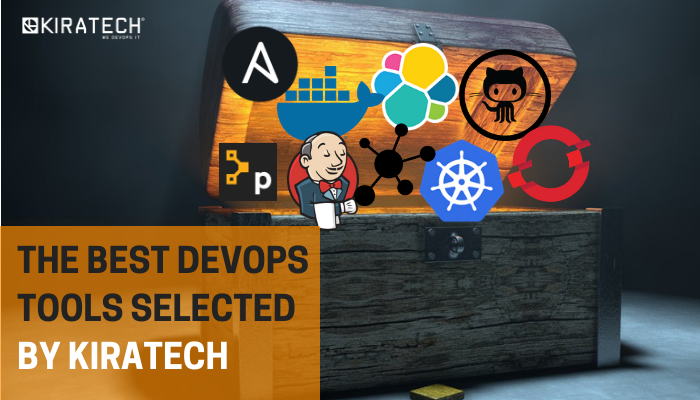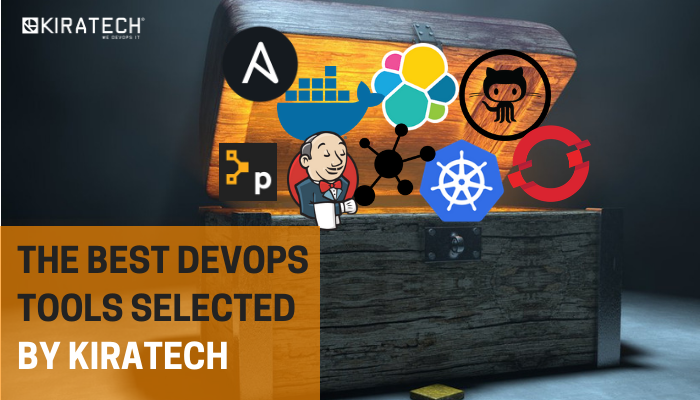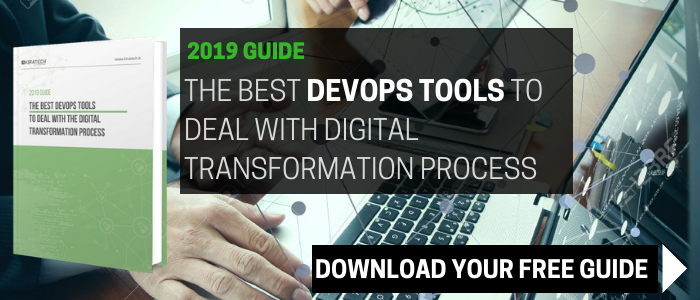
DevOps methodology is revolutionising the way companies are developing application and the way they are distributing them on the market. DevOps involves software development activities, IT Operations and all processes used by the IT department.
This methodology has a strong impact on company’s results and business, making the application development and distribution faster and accelerating the Time-To-Market to overcome the competition.
We are talking about an intensive work, that’s why the DevOps engineers are constantly looking for new tools.
One of the main problem is the lack of time to search for the new high-level DevOps technologies and to learn them. Another obstacle is represented by the presence of many alternatives on the market. So, where to start the research? Which are the best practices to implement in order to achieve the expected results?
In Kiratech, thanks to our great experience in this area, after making lots of researches and analysis, we created a complete list of the most affordable, secure and useful DevOps Tools.
The Best DevOps Tools
Jenkins
It is the most widespread Open Source software of Continuous Integration & Delivery, practice that allows to speed up the software release by working in an agile way and through optimisation and testing for a quick identification of any bugs.
Its Enterprise equivalent solution is CloudBees Jenkins Enterprise that helps companies to implement Continuous Integration and Continuous Delivery systems.
One of the main reason why it is the most used solution is for its quantity of plugins to interact with other tools (more than 1.000 today).
CloudBees Jenkins Enterprise is Jenkins as a Service, flexible solution that allows virtual, cloud or bare metal infrastructure execution. The Enterprise Edition is on-demand available to all teams and it offers more advantages than the opensource one:
- Few minutes projects Onboarding
- Integrated flexibility for Jenkins environments
- Jenkins automatic failover and recovery
- Advanced alerting, analytics and monitoring
- Users and projects security
Docker
Docker is an opensource project for application deployment automation inside the container software by providing some additions thanks to OS virtualization. Docker uses kernel Linux resources functionalities of isolation, like cgroups and namespaces, to allow independent containers to coexist in the same instance, avoiding the virtual machine installation and maintenance. One of the main Docker advantages is its portability.
Docker Enterprise version is “Docker Enterprise Edition” and helps companies to work faster thanks to its own Docker-ready platforms. It is a proper integration tool that allows Developers and Operations to collaborate during the whole Software creation and development lifecycle.
Kubernetes
Kubernetes is an open source platform that automates the operations on Linux containers, removing most of manual processes needed to deploy and scale the containerized applications. It is possible to create a cluster of host groups that run Linux containers and to use Kubernetes to manage these clusters in an easier and more efficient way. Clusters can include public cloud, private or hybrid hosts. Container-user companies usually choose Kubernetes for one of its main function, orchestration: it allows simultaneously interactions between containers’ teams, but also container registry planification and implementation and network, storage, security, telemetry services supply.
Red Hat OpenShift
Red Hat OpenShift is an application platform based on open source containers, built on Docker containers and orchestrated by Kubernetes container clusters management. Its enterprise version is Red Hat OpenShift Enterprise. Independently of the applicative architecture, OpenShift makes the creation, development and deployment activities easier and faster in every infrastructure, public or private.
Red Hat OpenShift is a PaaS (Platform as a Service) service after all, a cloud development environment through which the provider provides hardware, operative system, applicative platforms and the entire stack required for the development: web server, database system management, support tools, development tools and various useful resources for the applications realization and development.
A PaaS solution is designed to support the whole applications lifecycle: creation, test, management and update.
GitHub
GitHub is the largest source code web host in the world. It is both a social network and a files repository and offers both free hosting plans – for open source projects – and on-premise plans – for private software projects -. It democratized the code access to take new transparency level to organizations. GitHub changed the way a software is created, carrying collaboration and codes review directly inside the development process; it helps developers to found, re-use and contribute to the code. Thanks to GitHub, work has become faster and projects are getting smarter, as they start from the innovation process.
GitHub Enterprise is GitHub on-premise version. It makes collaboration development possible and available to a company’s software development team.
Elastic
The best log analytics software is Elastic that can be used in different areas, but one of the main is Big Data Analytics and Management, because it allows to access to a huge quantity of data immediately. We can’t forget to mention also its security and research application.
There are several reasons why a lot of enterprises choose this solution:
- It helps to draw utilities and advantages from large quantity of data, from Tweets flows to Apache logs and Wordpress blogs.
- It can produce report about users done activities, tendencies, organization developments, examined platforms’ usage and behaviour.
- It supports open-source, distributed, scalable and flexible software for real time research and analytics.
There are four different tools composing the Elastic Stack:
- Elasticsearch, a real time browser for large quantities of data and one of Elastic main tool.
- Logstash, designed for analysis and elaboration.
- Kibana for the real time visualization.
- X-Pack for monitoring, security and reporting.
Icinga
Icinga is one of the best tool to implement Continuous Monitoring because of its unique characteristics. It is extremely strong and flexible, keeping all the devices inside a network under control, making devices check and services automatic and notifying failures to the technical department. It is composed by Icinga Core (the monitoring software), a web portal (for the tool access through the browser) and some API to manage and automate the tool and the monitoring itself, making it the most DevOps friendly.
Ansible
Ansible involves configuration management, the application deployment and the activities automation, that provides a logic informatic infrastructure model by the identification, control and verification of all existing Configuration Items (element of configuration) versions.
It is a simple and agentless automation technology to improve the existing processes, to ensure the optimization through the application migration and to provide a unique language for the whole organization DevOps activity.
Puppet
Puppet is a resources and software management tool that allows to automate every step for the software development process, starting from the virtual and physical machines provisioning to configuration and reporting; from the first code development phases to testing, product release and next updates. There are two available Puppet versions: Open Source and Enterprise.
Puppet Enterprise includes a web graphic interface for the reports analysis, for the infrastructure control but it includes also advance functions to manage the updates and the maintenance, certifications management mechanisms and cloud provisioning tools.
Do you want to go in depth with all the advantages of these tools and the related practices? Download our DevOps Tools Complete Guide 2019, where we analysed the benefits of DevOps Methodology and of each tool, related to the business results it brought to our customers:








